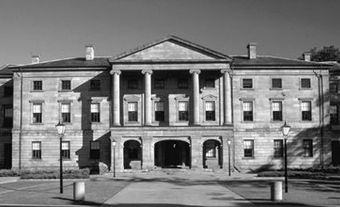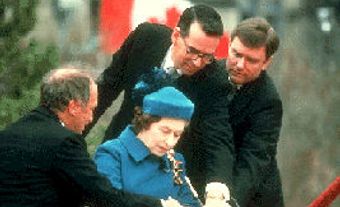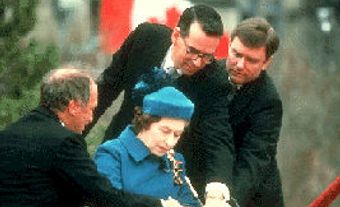The Constitution Act, 1982 is a landmark document. It allowed Canada to change its Constitution without the consent of Britain. This meant Canada had full independence. The Act also added the Charter of Rights and Freedoms to the Constitution. The Act was passed after a fierce, 18-month struggle. The Act was signed by Queen Elizabeth II on 17 April 1982.
(This article is a plain-language summary of the Constitution Act, 1982. If you are interested in reading about this topic in more depth, please see our full-length entry, Constitution Act, 1982.)

British Ties
Canada’s Constitution was at first made up of several British laws. The most crucial of these was the British North America Act. (It is now called the Constitution Act, 1867.) Also included were some constitutional conventions. These are unwritten rules. Only the British Parliament could amend (change) the Act.
With the Statute of Westminster, 1931, Britain began to grant full autonomy to the Commonwealth countries. This included Canada. But there was a problem. If Canada was to transfer constitutional power from Britain, how would this be done? Should the federal government do so on its own? Or did it need provincial consent? Did all the provinces need to agree? Or just a majority? Should all provinces be equal? Or should the larger ones have more say than the smaller ones? And should Quebec have a veto to protect the interests of French Canadians? Until Canadians could answer these questions, the power to change Canada’s Constitution stayed with Britain.
Pierre Trudeau and the Premiers
Since the 1930s, there had been many attempts to achieve constitutional change. A series of federal-provincial conferences had ended in failure.
The turning point came with the 1980 Quebec referendum. During the campaign, Prime Minister Pierre Trudeau promised to reopen constitutional talks. The separatists lost the referendum. Trudeau then began a process to create a charter of rights. He also sought an amending formula (a method for making changes).

But eight of the ten provinces opposed this. (See Gang of Eight.) So, Trudeau said he would proceed alone. He would ask Britain to change the BNA Act based on a resolution from Canada’s Parliament. But Opposition leader Joe Clark held up the resolution in the House of Commons. The premiers took Trudeau to court. In 1981, the Supreme Court of Canada issued a confused ruling. Legally, Trudeau could proceed with a resolution of the Senate and the House of Commons. But a constitutional convention required Ottawa to seek provincial support.
In November 1981, the federal government and all provinces but Quebec agreed on a proposal to send to Britain. The new Constitution would have a method for making changes. It would also include the Charter of Rights and Freedoms. Britain approved the deal. It was signed by Queen Elizabeth II on 17 April 1982.
What the Act Says: Parts 1–4
The first part of the Act is the Charter of Rights and Freedoms. It makes sure that the federal, provincial and territorial governments respect people’s rights and freedoms. However, it also includes the notwithstanding clause. This allows a government to pass a law that does not comply with the Charter. Such a law must be reviewed after five years.
The second part of the Act guarantees the rights of Indigenous peoples in Canada. But these rights are not defined. The third part involves equalization payments. The fourth part calls for the first ministers to meet before 17 April 1983. The purpose was to discuss the rights of Indigenous peoples.

Part 5: The Amending Formula
The fifth part of the Act contains the method for changing the Constitution. It requires approval from the Senate, the House of Commons, and at least two-thirds (seven) of the provinces. Those provinces would have to make up at least 50 per cent of Canada’s population. This is known as the 7/50 rule.
The consent of the Senate, the House of Commons and all 10 provinces is needed to change: the makeup of the Supreme Court; the use of French and English; the right of a province to have at least as many members of Parliament as senators; and anything affecting the Queen, the governor general or the lieutenant-governors.
Parts 6 and 7
The sixth part gives the provinces power over natural resources. (See Distribution of Powers.) The seventh part contains several minor clauses.
See also Constitution of Canada (Plain-Language Summary); Constitution Act, 1867 (Plain-Language Summary); Statute of Westminster, 1931 (Plain-Language Summary); Canadian Charter of Rights and Freedoms (Plain-Language Summary); Patriation of the Constitution (Plain-Language Summary).

 Share on Facebook
Share on Facebook Share on X
Share on X Share by Email
Share by Email Share on Google Classroom
Share on Google Classroom








